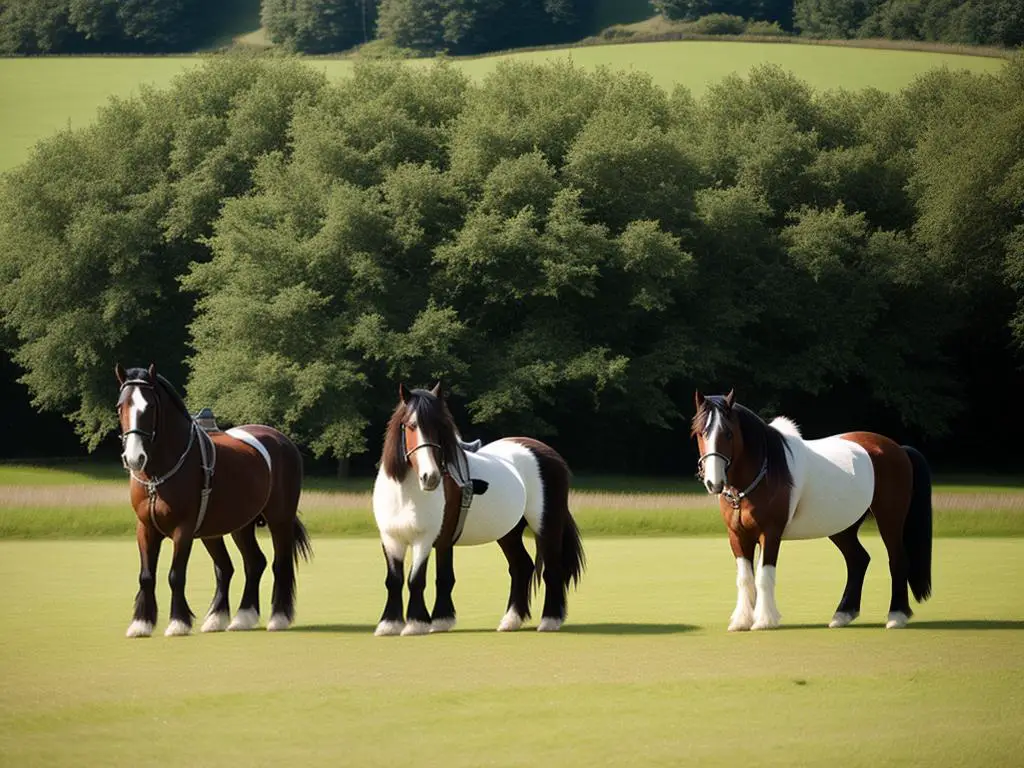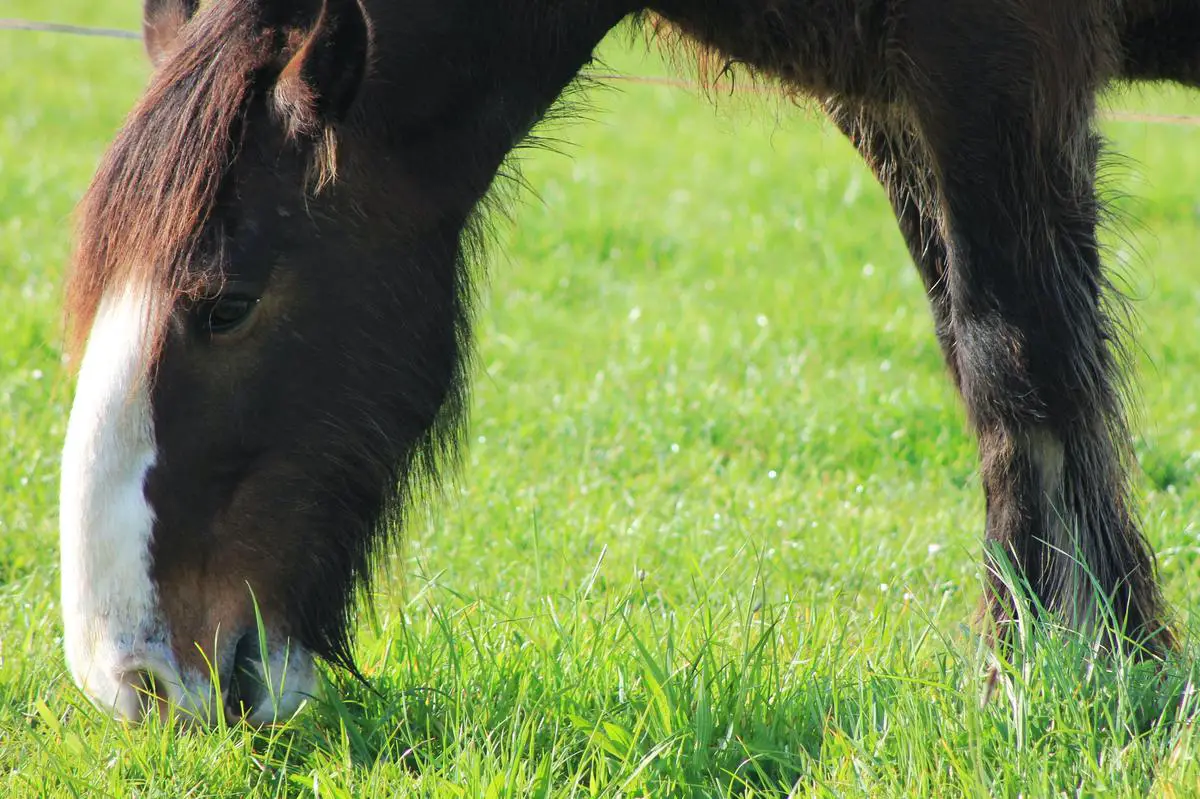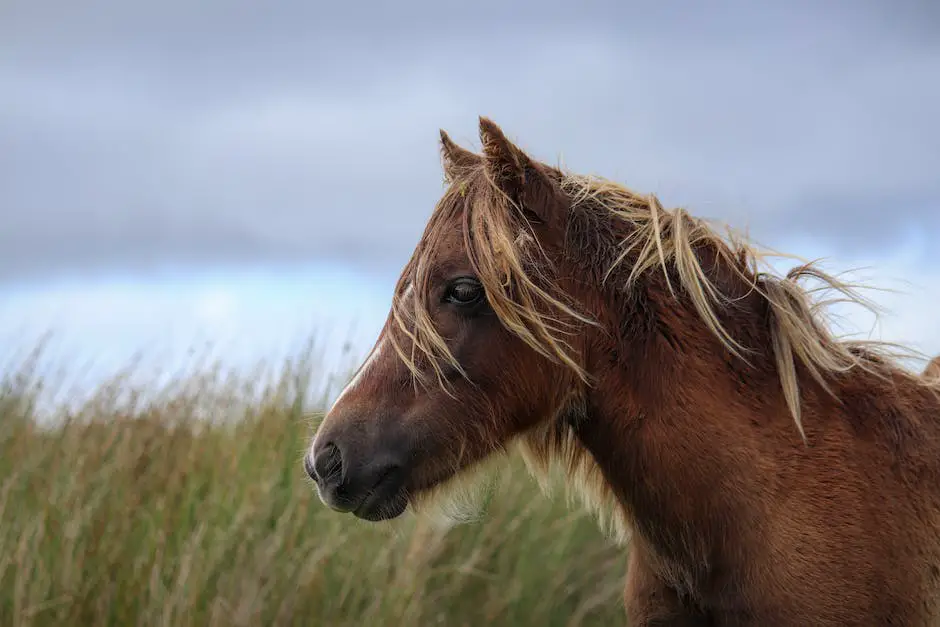As two of the most prominent draft horse breeds, the Shire horse and Clydesdale are renowned worldwide for their impressive size, power, and versatile applications. From their roots in Medieval times, when they were often seen in the castle and battlefield, these majestic creatures have established their vital role in the course of human history. The relationship between humans and these horses has been a key driver in their evolution, shaping them both physically and temperamentally to fit the various roles and tasks we have needed them to fulfill. Through examining each breed’s salient characteristics, their adaptability to myriad terrains and weather conditions, the precise care they require, and their place and value in modern societies, it becomes clear that these horses are not just ordinary beasts of burden, but indeed an inseparable part of our communal heritage.
Table of Contents (Horspedia)
Background and History
Background and History: The Shire Horse and Clydesdale, A Legacy Etched in Time
First originating in England, the Shire horse holds a robust history for its role in agriculture and industry. This breed came into existence during the medieval era, used prominently as a warhorse. These horses, known then as the “Great Horse,” were esteemed for their strength and ability to carry fully armored knights into battle. Over time, as machinery took over warfare, the Shire horse morphed into a staple of agricultural work – ploughing fields, hauling heavy loads, and pulling carts.
The rise of modern machinery in the 20th century diminished the Shire horse’s primary roles, resulting in a significant breed decline. However, with the recent surge in interest for this breed, the Shire horse’s strength, intelligence, and amicable nature have found them new roles in forestry, advertising, and promotional work. These gentle giants have even found a place in therapeutic riding programs, proving their inherent versatility and amiable temperament.
Conversely, Clydesdales owe their origins to Scotland, where they were explicitly bred during the early 19th century to meet agricultural requirements. Their name is derived from the valley (or ‘dale’) of the River Clyde. Originally used for heavy drafting and agricultural purposes, Clydesdales played a pivotal role in the Industrial Revolution, transporting goods from canals and docks to their final destinations.
Budweiser, an American brewing company, is often credited with boosting the Clydesdale’s popularity during the 20th century when they used them in various ads and promotional activities. The Clydesdale horses are now an iconic symbol in America for their strength and perseverance, often featured in parades, shows, and commercials.
Although Clydesdales face a similar threat as the Shire horses with the rise of machinery and modern agricultural practices, they continue to find their place in society. Presently, besides their promotional work, they serve in forestry operations, riding schools, and are notably active in various equestrian disciplines.
Comparing the Shire Horse and Clydesdale
Both the Shire and Clydesdale horses are famous for their imposing size, remarkable strength, and gentle temperament. While the Clydesdale proves to be more agile and trainable, making it exceptional for riding, the Shire outshines in heavy draft work because of its unmatched strength, and considerably larger size. Clydesdales are also noted for their increased presence of feathers – the long hair that adorns their legs, as compared to the Shire horses.
Looking at their physical characteristics, Clydesdales are primarily seen in bay and brown shades and are distinguished by their white facial and leg markings. Shire horses make a bold impression with their black, bay, or gray coats.
Despite their contrasting traits, both the breeds share a rich historical significance and are cherished members of communities around the globe, creating a profound legacy that spans across time and function.

Physical Characteristics and Behavioral Traits
Physical Attributes of Shire and Clydesdale Horses
The Shire and Clydesdale horses manifest notable similarities and differences in their physical traits, despite both being recognized as large-sized draft horses.
Recognized as one of the tallest horse breeds, Shire horses measure between 16.2 to 17.2 hands high, with many individuals towering over 18 hands. They boast a muscular, robust physique complemented by a broad chest, an articulate head, and large, expressive eyes. Their coats can be black, bay, or gray. One characteristic trait of Shire horses is their substantial “feathering” — the thick hair surrounding their hooves.
On the other hand, Clydesdale horses embody a unique combination of size and elegance. Their height usually ranges from 16 to 18 hands high, and they exemplify a lean, yet muscular build. Much like the Shire horses, Clydesdales also feature “feathering” around their hooves. Predominantly bay-colored, Clydesdales can also be seen in shades of black, chestnut, and roan. They are renowned for their long legs and large hooves, contributing to their signature high-stepping walk.
Comparing Temperaments and Behavior
When it comes to their temperament and behavior, both Shire and Clydesdale horses are known for their calm, docile, and generally gentle nature. They can be trained effectively due to their observant nature and adaptability to commands. However, because of their massive size and strength, training these horses require experience and patience.
Shire horses are noted for their friendly demeanor, often used for carriage-driving and as a riding horse. They are relatively tranquil, making them suitable for various activities ranging from agriculture to public service jobs.
Similarly, Clydesdale horses are easily trainable, with a versa quiet and willing nature, often applied in heavy draft work, ridden pleasure, and also as parade horses. These horses are still frequently used for farming, hauling, and other duty tasks due to their strength, endurance, and hardworking nature.
Health Concerns
In terms of health issues, both breeds have their own individual concerns to note, mainly owing to their size and genetic heritage.
Shire horses, because of their unique featherings, are often susceptible to chronic progressive lymphedema, a condition that causes swelling in their lower legs. They can also fall prey to several other health problems including equine polysaccharide storage myopathy (EPSM), heart diseases, and hoof problems.
Clydesdale horses, on the other hand, are prone to equine metabolic syndrome associated with insulin resistance, obesity, and laminitis. They may also be subjected to some common health problems seen in large breeds such as developmental orthopedic disease (DOD), and osteochondrosis (OCD), which affect the horse’s joints.
Longevity and Versatility
Despite certain health risks, both the Shire and Clydesdale horse breeds can enjoy a lifespan of 18 to 25 years with proper care, a nutritious diet, and regular veterinary visits. These breeds are particularly noted for their strength and size, which makes them suitable for carrying out a versatile range of tasks.

Usage in Different Terrains and Weather Conditions
Adapting to Varied Environments: A Look at the Shire and Clydesdale Horses
Noted for their impressive strength, agility, and adaptability to a wide range of weather and terrains, both the Shire and Clydesdale breeds are draft horses that were originally bred for heavy labor and transportation.
Focusing on the Shire Horse: The Gentle Giant
The Shire horse, which ranks as one of the largest horse breeds worldwide, is well adapted for hard labor and tough conditions. Standing between 17 and 19 hands (68 to 76 inches) tall, these horses have been bred for generations to pull heavy loads in all weather conditions.
The Shire horse breed stands out for their distinctive leg feathers that provide ample protection in cold, wet environments. The breed came originally from England’s damp and cold midlands, and is therefore, comfortably acclimatized to humid and rainy weather. Their thick coat offers defense against the cold, and their large hooves empower them with excellent navigation through muddy terrains, a common feature in their native climate.
Being highly adaptable, Shire horses have shown their ability to flourish in different climates, from the damp pastures of the Pacific Northwest to the dry Southwest in America. Their impressive size, power, and endurance make them a go-to choice for varied work duties, irrespective of the terrain.
Clydesdale: The Scottish Powerhouse
Originating from Scotland, Clydesdales earned their name from the Clyde River Valley, a region known for its harsh weather and rugged landscapes. They were initially bred for arduous agricultural and heavy draft tasks, owing to their incredible strength and perseverance.
Similar to Shires, Clydesdales bear the hallmarks of dense and warm coats, large, steady hooves, and distinct leg feathers. These traits are not only aesthetically pleasing but also highly functional, allowing the horses to maneuver through waterlogged and frigid terrains with ease.
Flaunting sturdy, round feet, Clydesdales are particularly suited for heavy duty tasks on various surfaces, comfortably adapting to challenging terrains. Owing to their impeccable endurance, they can thrive in colder climates, while still adjusting well to warmer areas. This is probably why they have gained popularity across North America.

Care and Maintenance
Nutritional Requirements: Powering These Majestic Breeds
Given the similar sises and energy expenditures of Clydesdales and Shire horses, their dietary needs are broadly alike. A balanced diet consisting of high-quality hay or pasture, appropriate grains, and a fair amount of vitamin and mineral supplements is essential for their wellbeing. Both breeds usually require about 1.5-2% of their body weight in forage on a daily basis, though this could vary based on factors such as the horse’s age, weight, and activity level.
Common Health Issues: Potential Speed Bumps on the Road of Care
Both Shire and Clydesdale horses are prone to certain health issues due to their size and breed characteristics. Both breeds can suffer from Chronic Progressive Lymphedema, a condition which causes swelling in the lower limbs. They are also prone to develop Equine Metabolic Syndrome, which can lead to laminitis, a painful inflammatory condition of the tissues (laminae) that bond the hoof wall to the pedal (coffin) bone in the horse’s hoof.
Shire horses have a higher incidence of Shivers, a neuromuscular disease that affects the horse’s ability to move its hind legs properly. Conversely, Clydesdales tend to be more prone to developing Degenerative Suspensory Ligament Desmitis (DSLD), a condition that affects the ligaments in the lower limbs, causing pain and lameness.
Grooming Requirements: Keeping Their Coats & Feathers Clean
As it comes to grooming, both Clydesdales and Shire horses require a bit more care compared to other horse breeds due to their long hair known as “feathering” on the lower legs. Feathers need regular washing and combing to prevent mud fever and other skin conditions.
For Shires that have a heavy double coat, it should be groomed regularly to prevent matting and to keep the skin healthy. Whereas, the short and smooth coat of a Clydesdale generally requires less intense grooming but consistent maintenance is still recommended.
Maintaining Healthy Shire and Clydesdale Horses
Proper care for Shire and Clydesdale horses extends beyond addressing dietary needs, managing potential health concerns, and consistent grooming. Due to their size and strength, Shire and Clydesdale breeds require abundant physical exercise along with mental stimulation to maintain their overall health. It’s essential to approach these substantial breeds confidently to ensure their tranquility and responsiveness.
Routine veterinary visits, timely vaccinations, and consistent deworming are other crucial aspects of maintaining their health. Their dental care should also not be overlooked, which guarantees their ability to properly process their high-fiber diet.
Strong bonds between these breeds and their handlers have been noted thanks to their social nature. Regular interactions, whether through grooming, feeding, or training, aid in fostering this connection and promoting their well-being.
Due consideration should be given to the responsibility that accompanies owning a Shire or Clydesdale horse, given their specific care requirements and sizable stature. Nevertheless, with proper care and management, these gentle behemoths make for loyal and charming companions.

Value and Prestige in Society
Shire Horse and Clydesdale: Uniqueness in Equestrian Sports
In equestrian sports, the formidable stature of Shire and Clydesdale horses indeed stand out, be it in pulling contests, driving competitions or agricultural demos. Their strength and majesty are unparalleled in such events.
Clydesdales notably hold substantial value in parades and display arenas, primarily due to their historical association with the renowned Budweiser beer company in the United States. As key figures in Budweiser’s advertising since 1933, these horses captivate audiences at parades and grand events, signifying their deep-seated cultural relevance.
Conversely, Shire horses are traditionally renowned for their immense power in tasks like heavy horse ploughing competitions, a traditional sport still appreciated among rural communities worldwide.
Breeding Value: Shire Horse vs Clydesdale
When it comes to breeding, both the Shire and Clydesdale breeds are highly sought after, largely due to their characteristics of power, stamina and steadiness.
Clydesdale breeders, especially in U.S.A and Canada, treasure these horses partly because of a longstanding tradition connecting the breed with brewing – the aforementioned Budweiser Clydesdales. Ample funding is set aside for the breeding and upkeep of these horses to maintain the lineage and purity of the breed.
The Shire breed, while less widespread, still holds a crucial role in preserving British agricultural heritage. In North America, there is a growing interest in the Shire horse breed, particularly in the context of sustainable farming practices. Shires’ unique combination of power and docile temperament makes them an excellent choice for organic agriculture or other work scenarios where large machinery is impractical or undesirable.
Prestige and Influence on Horse Culture
In the area of prestige and influence on horse culture, both the Shire and Clydesdale breeds have left their indelible prints. The Clydesdale has arguably gained more general recognition, predominantly because of their universal presence in yearly holiday commercials. The image of the Clydesdale team pulling the famous red beer wagon is a symbol of American culture and history.
The Shire horse, although perhaps less-known globally, has significant cultural and historical importance in the UK. It represents British farming history, embodying strength, diligence, and resilience. Historical re-enactments often feature Shires, furthering their prestige and status in the UK horse culture.
In conclusion, the social value and prestige of the Shire and Clydesdale breeds are distinct yet substantial, spanning across sports, breeding and entertainment sectors. Although varying in specifics, both breeds contribute significantly to enriching the horse culture both locally and internationally.

Ultimately, the Shire and Clydesdale horses, with their strength and endurance, good nature, and historical importance, have earned a noted presence both in work fields and breeding stables, as well as becoming the heartthrobs at sporting events and entertainment parades. Their roles may have evolved over time, and modern society may no longer require their labor as it once did, yet their timeless appeal and distinguished reputation project an enduring charm that keeps them relevant and valued. The influence they have on horse culture is significant and enduring, and the relationship shared with these horses is a beautiful testament to the profound bond between humans and our equestrian companions.
